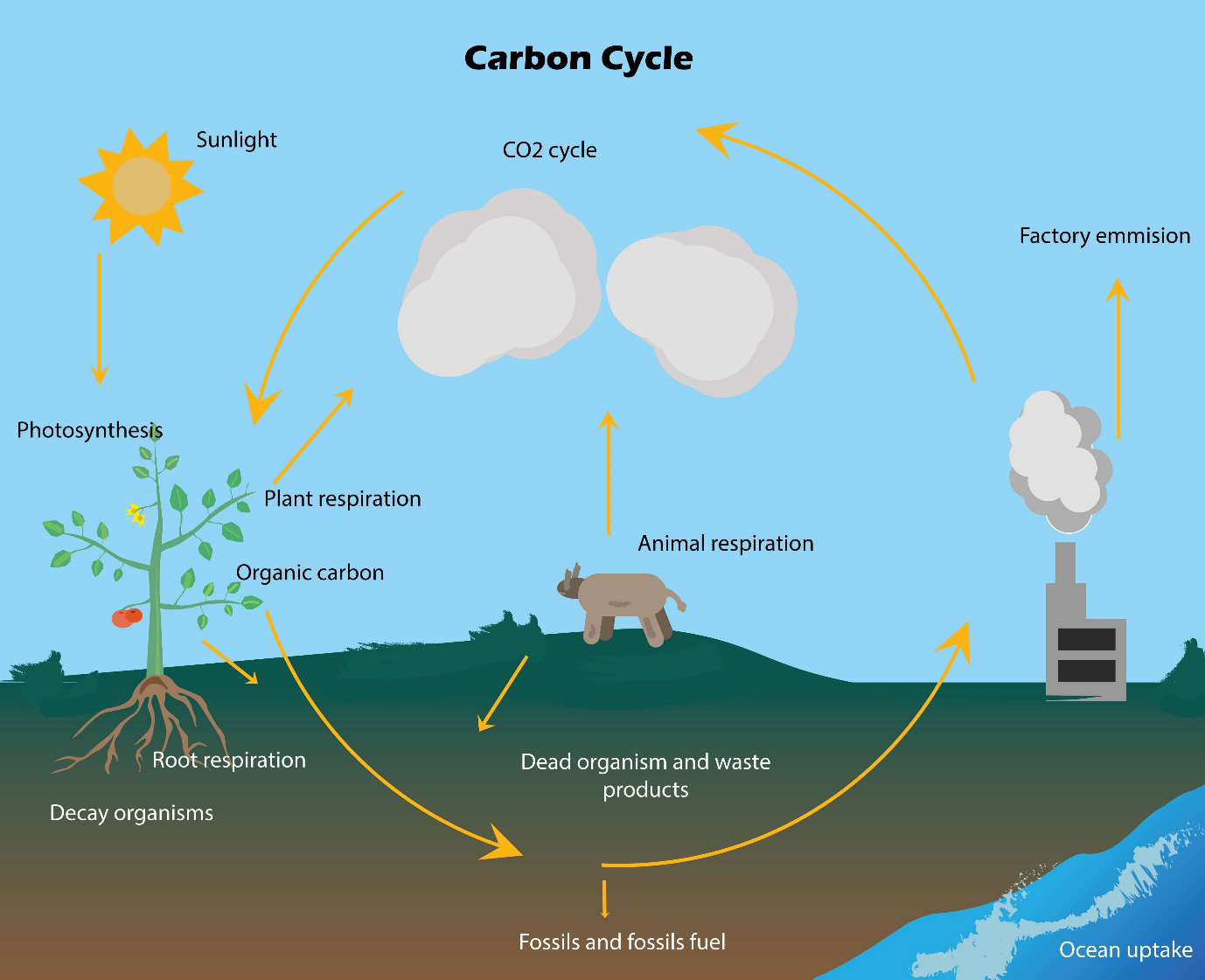
Which step is not involved in the carbon cycle?
(a) Photosynthesis
(b) Respiration
(c) Transpiration
(d) Combustion of fossil fuels
Answer
478.8k+ views
Hint: The carbon cycle includes all the processes that consume or release carbon compounds from/ to the environment. The step that is not involved among the following is related transport of substances through xylem tissue in plants.
Complete answer:
Carbon is one of the most important components of biological compounds as well as a major component of many minerals like the limestone. The carbon cycle describes the movement of carbon in the environment as it is recycled and reused throughout the biosphere. It also describes the long- term processes of carbon sequestration and carbon release to and from the carbon sinks.
In the atmosphere, carbon dioxide and methane are the most common forms of carbon. Of these gases, carbon dioxide is consumed from the atmosphere in the process of photosynthesis, while it is released to the atmosphere as a by- product of respiration in all the organisms. Thus, photosynthesis and respiration are an integral part of the carbon cycle.
Burning of fossil fuels results in the formation of smoke and gases such as carbon monoxide and carbon dioxide, thus adding to the carbon in the atmosphere. So, the burning of fossil fuels also plays a role in the carbon cycle.
Transpiration however is primarily a process that is used for the gaseous exchange and release of water vapors into the atmosphere and thus not playing any direct role in the carbon cycle.

So, the answer is, “Transpiration”.
Additional Information:
The carbon cycle which was first discovered by Antoine Lavoisier and Joseph Priestly and later popularized by Humphry Davy. The global carbon cycle is usually divided into the major reservoirs of carbon that are interconnected by pathways of exchange. The reservoirs are:
- The atmosphere - The terrestrial biosphere - The oceans, including dissolved inorganic carbon and the biotic and abiotic marine biota - The sediments, which include fossil fuels, freshwater systems, and non- living organic compounds - The Earth's interior, i.e. its mantle and crust
Note: Along with the carbon cycle, the water cycle and the nitrogen cycle are the sequences of events that are the keys to make Earth capable of sustaining life. The water cycle is the cycle that comprises the evaporation of water from various sources to its replenishment through the rains. The nitrogen cycle is also a biogeochemical process in which nitrogen is converted to multiple chemical forms by the interaction with environmental factors and the organisms.
Complete answer:
Carbon is one of the most important components of biological compounds as well as a major component of many minerals like the limestone. The carbon cycle describes the movement of carbon in the environment as it is recycled and reused throughout the biosphere. It also describes the long- term processes of carbon sequestration and carbon release to and from the carbon sinks.
In the atmosphere, carbon dioxide and methane are the most common forms of carbon. Of these gases, carbon dioxide is consumed from the atmosphere in the process of photosynthesis, while it is released to the atmosphere as a by- product of respiration in all the organisms. Thus, photosynthesis and respiration are an integral part of the carbon cycle.
Burning of fossil fuels results in the formation of smoke and gases such as carbon monoxide and carbon dioxide, thus adding to the carbon in the atmosphere. So, the burning of fossil fuels also plays a role in the carbon cycle.
Transpiration however is primarily a process that is used for the gaseous exchange and release of water vapors into the atmosphere and thus not playing any direct role in the carbon cycle.

So, the answer is, “Transpiration”.
Additional Information:
The carbon cycle which was first discovered by Antoine Lavoisier and Joseph Priestly and later popularized by Humphry Davy. The global carbon cycle is usually divided into the major reservoirs of carbon that are interconnected by pathways of exchange. The reservoirs are:
- The atmosphere - The terrestrial biosphere - The oceans, including dissolved inorganic carbon and the biotic and abiotic marine biota - The sediments, which include fossil fuels, freshwater systems, and non- living organic compounds - The Earth's interior, i.e. its mantle and crust
Note: Along with the carbon cycle, the water cycle and the nitrogen cycle are the sequences of events that are the keys to make Earth capable of sustaining life. The water cycle is the cycle that comprises the evaporation of water from various sources to its replenishment through the rains. The nitrogen cycle is also a biogeochemical process in which nitrogen is converted to multiple chemical forms by the interaction with environmental factors and the organisms.
Recently Updated Pages
Can anyone list 10 advantages and disadvantages of friction

What are the Components of Financial System?

How do you arrange NH4 + BF3 H2O C2H2 in increasing class 11 chemistry CBSE

Is H mCT and q mCT the same thing If so which is more class 11 chemistry CBSE

What are the possible quantum number for the last outermost class 11 chemistry CBSE

Is C2 paramagnetic or diamagnetic class 11 chemistry CBSE

Trending doubts
Which is not a source of freshwater 1 Glaciers and class 11 chemistry CBSE

10 examples of friction in our daily life

The correct order of melting point of 14th group elements class 11 chemistry CBSE

Difference Between Prokaryotic Cells and Eukaryotic Cells

One Metric ton is equal to kg A 10000 B 1000 C 100 class 11 physics CBSE

What is the specific heat capacity of ice water and class 11 physics CBSE




